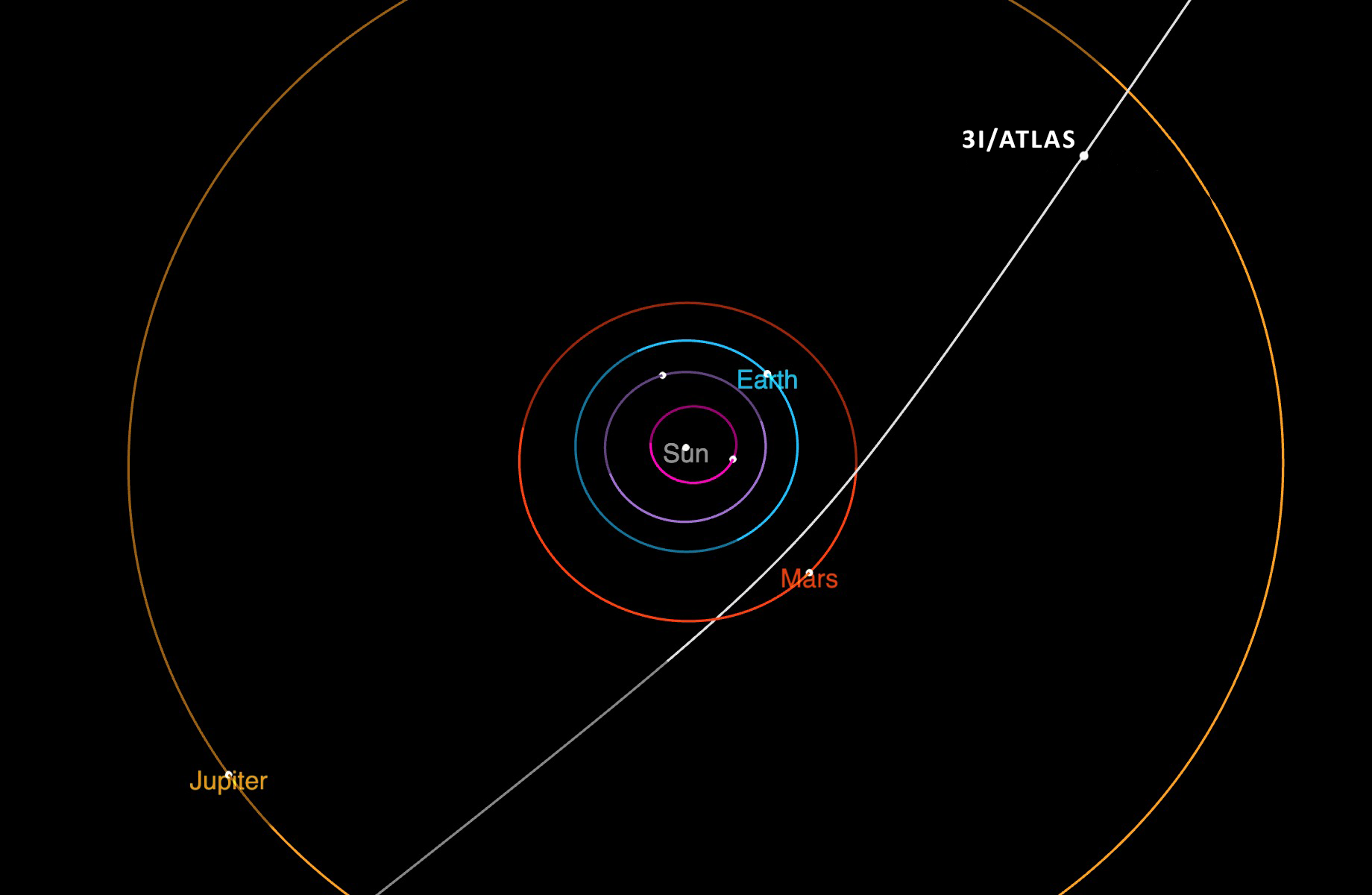
Comet 3I/ATLAS is a chunk of ice and dust originating from outside our solar system, now making a one-time pass through it. It was first spotted on July 1, 2025, by a telescope designed to watch for potential Earth-threatening asteroids. According to NASA’s detailed profile on comet 3I/ATLAS, the discovery happened using the Asteroid Terrestrial-impact Last Alert System, or ATLAS, located in Rio Hurtado, Chile (NASA, 2025). This system scans the sky nightly for moving objects, and on that date, it flagged a faint dot traveling at an extraordinary pace. Pre-discovery images later traced it back to June 14, 2025, allowing astronomers to refine its path quickly.

The comet’s name combines its interstellar designation “3I” for the third such object with “ATLAS” honoring the discovery team. Comets like this are frozen relics, preserving materials from their birthplaces, and this one’s detection relied on advanced surveys that have revolutionized how we spot distant visitors. For comparison, imagine finding a snowball tossed from another country into your backyard; that’s the thrill here. Observations soon confirmed its cometary nature through a surrounding cloud called a coma, which forms as sunlight warms the ice.
Experts note that such finds are becoming more common thanks to better technology, but each one is unique. The initial alert went to the Minor Planet Center, where global teams verified the data. This process ensures accuracy, as false positives can occur with fast-moving objects. In fact, the comet appeared as a teardrop-shaped blur in early images, hinting at dust release even far from the Sun.
Why Is 3I/ATLAS Considered Interstellar?
Objects in our solar system typically follow elliptical orbits around the Sun, bound by its gravity like planets in a racetrack. But 3I/ATLAS breaks that rule with a hyperbolic trajectory, meaning it’s on an open path that will fling it back into deep space after a brief visit. As explained in ESA’s tracking report on the rare interstellar comet, this shape confirms it came from interstellar space, not our local Oort Cloud (European Space Agency, 2025). The orbit’s eccentricity, a measure of how stretched it is, clocks in at about 6.08, far above 1, which is the threshold for unbound paths.

This classification stems from precise calculations of its speed and direction. If an object moves too fast for the Sun’s pull to capture it, it’s deemed interstellar. For 3I/ATLAS, its velocity at infinity the speed it would have far from any gravitational influence is around 57 kilometers per second (km/s). That’s like a car racing at highway speeds but in space terms. Comparisons to previous interlopers show similarities: ‘Oumuamua had a velocity of 26 km/s, while Borisov was at 32 km/s, but this one’s higher pace suggests a long journey through the galaxy.
Uncertainties exist in these figures due to observational limits, but multiple sources agree on the hyperbolic nature. For instance, if we plot its path backward, it points to origins beyond our system, possibly ejected from another star’s orbit billions of years ago. This makes it a messenger from alien realms, carrying unaltered samples of distant chemistry.
What Is the Size and Composition of 3I/ATLAS?
Estimating the size of a distant comet involves measuring its brightness and assuming reflectivity, known as albedo. Recent data pegs the nucleus the solid icy core of 3I/ATLAS at an upper limit of 5.6 kilometers in diameter, though it might be as small as 320 meters across. In NASA’s Hubble study on the interstellar comet, observations from July 21, 2025, refined this by capturing a dust cocoon around the nucleus (NASA, 2025). This teardrop shape indicates active outgassing, where ice turns to vapor.
Composition-wise, it’s primarily water ice mixed with dust and gases, typical for comets. Photometric colors, which analyze light wavelengths, show a reddish tint with a spectral slope of 16.0 percent per 100 nanometers (a unit for light waves). From the arXiv paper on its discovery and description, measurements reveal dust production at 0.1 to 1.0 kilograms per second, with particles ejected at 0.01 to 1 meter per second (Karpov, 2025). Think of it as a dirty snowball melting slowly, releasing micrometer-sized grains.
The coma, a gaseous envelope, spans thousands of kilometers, with a cross-section of about 185 square kilometers assuming 10 percent albedo. For visualization, picture a fuzzy ball larger than some cities. Slight variations in size estimates arise from distance, but the range 320 meters to 5.6 km holds across sources. This composition hints at formation in a cold, distant environment, unlike our solar system’s comets.
- Bullet for fun fact: If the nucleus is 5.6 km across, that’s roughly the width of Manhattan Island, but far icier.
What Path Is 3I/ATLAS Taking Through Our Solar System?
Entering from the southern sky, 3I/ATLAS follows a slingshot-like arc around the Sun. It will reach perihelion, its closest solar point, on October 30, 2025, at 1.4 astronomical units (AU), or 210 million kilometers about Mars’ orbital distance. As per ESA’s Hubble news on the comet’s size estimate, after that, it swings outward, never to return (European Space Agency, 2025). Its closest Earth approach is 1.8 AU, or 270 million kilometers, posing no threat.
The path’s hyperbolic curve means entry and exit at high angles to the ecliptic plane (the flat disk where planets orbit). Traced back, it likely wandered the Milky Way for billions of years. For a visual, refer to orbital diagrams in agency releases, showing a sharp bend near the Sun due to gravity.
Measurements show consistency, with perihelion distance fixed at 1.4 AU across reports. This trajectory allows observations from both hemispheres, enhancing data collection.
How Fast Is 3I/ATLAS Traveling?
Speed varies with solar distance, but at discovery, 3I/ATLAS clocked 61 km/s, or 221,000 kilometers per hour. Sources note slight differences: one estimate is 60 km/s, another 58 km/s, reflecting measurement precision. In ESA’s comet tracking update, it’s traveling roughly 60 km/s relative to the Sun (European Space Agency, 2025). That’s faster than any human-made probe, like Voyager 1 at 17 km/s.

As it nears perihelion, gravity accelerates it further. This velocity (in km/s, a standard unit for space speeds) confirms its unbound status, as solar escape velocity at 1 AU is about 42 km/s. For context, it’s like a bullet train in vacuum, gaining speed from stellar encounters over eons.
The range 58-61 km/s accounts for observational uncertainty, but all agree it’s the fastest recorded visitor.
Why Are Scientists So Excited About Studying This Comet?
Interstellar comets like 3I/ATLAS are time capsules from other stars, revealing how planets form elsewhere. Their composition can match exoplanet data, bridging gaps in knowledge. As highlighted in NASA’s comet 3I/ATLAS overview, astronomers worldwide are probing its properties to understand distant environments (NASA, 2025). Unlike local comets altered by solar heat, this one preserves pristine materials.
Excitement stems from potential volatiles (gases like carbon monoxide) indicating birth conditions. It’s active far out, suggesting volatile ices. Comparisons: Borisov had cyanide, hinting at universal chemistry.
- Reasons in bullets: Opportunity for spectroscopy (light analysis for elements); Tests formation theories; Rare event, only third known.
This could refine models of galactic object populations.
What Observations Have Been Made So Far?
Telescopes have imaged 3I/ATLAS since discovery. Hubble captured it on July 21, 2025, at 277 million miles from Earth, showing a dust tail. In NASA’s Hubble size estimate report, the dust-loss rate matches distant comets (NASA, 2025). Ground facilities like Palomar provided colors.
It remains visible until September 2025, vanishes behind the Sun, then reappears in December. ESA uses Hawaiian, Chilean, and Australian scopes for ongoing monitoring.
For complex data like light curves (brightness changes), see agency figures plotting variations.
Could Future Missions Study Interstellar Comets Like This?
While no mission targets 3I/ATLAS due to its speed, future ones prepare. ESA’s Comet Interceptor, launching 2029, waits at Lagrange Point 2 for pristine or interstellar comets. As noted in ESA’s interstellar comet report, it could intercept similar visitors (European Space Agency, 2025). This three-spacecraft setup would fly through the coma, sampling directly.
Such missions address flyby challenges, like high relative speeds (up to 70 km/s). For now, remote study dominates, but Interceptor represents hope for hands-on analysis.
In summary, comet 3I/ATLAS offers a fleeting window into the cosmos beyond, with its interstellar origins and active nature sparking global research. As it races away, the data gathered could reshape our view of the galaxy’s icy wanderers. What other secrets might the next interstellar visitor reveal?
References
European Space Agency. (2025, July 3). ESA tracks rare interstellar comet. https://www.esa.int/Space_Safety/Planetary_Defence/ESA_tracks_rare_interstellar_comet
European Space Agency. (2025, August 7). Hubble makes size estimate of interstellar comet. https://esahubble.org/news/heic2509/
Karpov, S. (2025). Interstellar comet 3I/ATLAS: discovery and physical description. arXiv. https://arxiv.org/abs/2507.05252
NASA. (2025, July 3). Comet 3I/ATLAS. NASA Science. https://science.nasa.gov/solar-system/comets/3i-atlas/
NASA. (2025, August 7). As NASA missions study interstellar comet, Hubble makes size estimate. NASA Science. https://science.nasa.gov/missions/hubble/as-nasa-missions-study-interstellar-comet-hubble-makes-size-estimate/
📌 Frequently Asked Questions
What is an interstellar comet?
An interstellar comet is an icy body from outside our solar system, unbound by the Sun’s gravity. According to NASA’s comet explanations, it follows a hyperbolic path, unlike local comets (NASA, 2025). This allows study of alien materials.
How was comet 3I/ATLAS discovered?
It was found on July 1, 2025, by the ATLAS telescope in Chile scanning for asteroids. As per ESA’s discovery details, follow-up confirmed its interstellar status (European Space Agency, 2025).
Why is 3I/ATLAS moving so fast?
Its speed of about 60 km/s comes from gravitational boosts over billions of years. In Hubble’s observations, this is the highest for a visitor (European Space Agency, 2025), enabling escape from any star system.
What is the size of comet 3I/ATLAS?
The nucleus is up to 5.6 km across, possibly smaller. From NASA’s Hubble data, estimates use brightness measurements (NASA, 2025).
Is 3I/ATLAS dangerous to Earth?
No, its closest approach is 270 million km. As stated in ESA’s safety assessment, it poses no risk (European Space Agency, 2025).
What makes 3I/ATLAS different from other comets?
It’s interstellar, with pristine composition from another system. Unlike ‘Oumuamua, it’s active with a coma, per research descriptions (Karpov, 2025).
When will 3I/ATLAS be closest to the Sun?
On October 30, 2025, at 1.4 AU. Details in NASA’s orbital info show this perihelion (NASA, 2025).
Can I see 3I/ATLAS with a telescope?
Yes, until September 2025 for amateurs with large scopes. ESA’s visibility guide notes it reappears in December (European Space Agency, 2025).
What is the composition of 3I/ATLAS?
Mostly ice and dust, with a reddish color. From photometric studies, it releases dust at 0.1-1 kg/s (Karpov, 2025).
Are there plans to send a spacecraft to 3I/ATLAS?
No, but ESA’s 2029 Comet Interceptor could target similar ones, as per mission plans (European Space Agency, 2025).
Leave a Reply